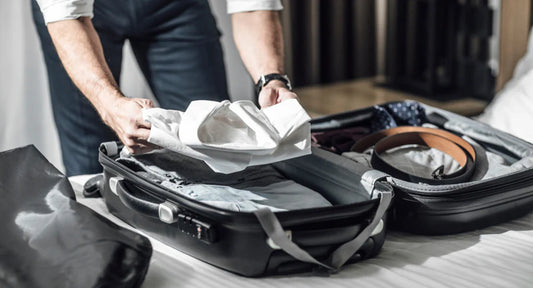Evolution of men formal wear: A Brief History of Men’s Suits
Share
Men's formal wear has evolved significantly throughout history, reflecting the changing social and cultural landscape. The suit has undergone a fascinating transformation from the early days of frock coats and waistcoats to the modern-day tuxedo. Understanding this evolution not only provides a deeper appreciation for the craftsmanship and artistry behind men's formal wear but also helps us appreciate classic styles' enduring appeal.
Early Beginnings of Men's Formal Wear
The birth of the modern suit can be traced back to the 19th century when men's fashion began to move away from the more flamboyant styles of the previous era. The frock coat, a long tailcoat garment, was a popular choice during this time, often paired with a waistcoat and trousers. As the century progressed, the suit became increasingly tailored and streamlined, with the introduction of the double-breasted jacket and the lounge suit.

The Influence of British Tailoring
British tailoring has played a pivotal role in shaping the evolution of men's formal wear. Savile Row, a street in London renowned for its bespoke tailors, has been at the forefront of men's fashion for centuries. The meticulous attention to detail and focus on quality craftsmanship that characterize British tailoring have had a profound impact on the development of the modern suit.
The Roaring Twenties and the Rise of Modern Elegance
The 1920s saw a dramatic shift in men's fashion with the introduction of the tuxedo and the rise of double-breasted suits. A sense of sophistication and elegance characterized this era, and men's formal wear reflected this new attitude. Accessories such as bow ties and pocket squares became increasingly important, adding a touch of personality to formal attire.

Mid-20th Century: The Golden Age of Men's Formal Wear
The mid-20th century is often considered the golden age of men's formal wear. The 1950s saw a return to classic elegance, with a focus on tailored suits, slim ties, and polished shoes. Hollywood stars like Cary Grant and Fred Astaire helped to popularize these styles, making them synonymous with sophistication and success.

The 1960s and 70s brought a wave of experimentation and revolution in men's fashion. The conservative suits of the early 60s gave way to bolder colors, wider lapels, and flared trousers as the cultural revolution took hold.
The Late 20th Century to Today: Revival and Reinvention
The late 20th century and early 21st century have seen a revival of interest in classic men's formal wear. However, there has also been a trend towards more modern and innovative styles. The power suit of the 1980s, characterized by broad shoulders and bold colors, gave way to the more minimalist suits of the 1990s. Today, men's formal wear is a blend of tradition and innovation, with designers incorporating classic elements into contemporary styles.
Timeless Elements of Men's Formal Wear
Despite the evolution of men's formal wear, certain elements have remained timeless. With its clean lines and tailored fit, the suit itself is a classic garment that always stays in style. The importance of quality fabrics, such as wool and cashmere, has also endured throughout history. Finally, attention to detail, from the perfect fit to the subtle accessories, is what truly sets apart a well-dressed man.

How to Incorporate Classic Styles into Modern Wardrobes
The beauty of classic men's suits is their versatility. You can effortlessly blend traditional elements with modern trends to create a timeless and contemporary wardrobe. Consider incorporating a classic navy or charcoal suit into your rotation, but pair it with a modern slim-fit shirt and a patterned tie for a touch of personality. Feel free to experiment with different textures and accessories to create a look that is uniquely your own.
Conclusion
The evolution of men's formal wear is a testament to the enduring power of style and self-expression. From the refined elegance of the 1920s to the bold experimentation of the 1970s and the modern sophistication of today, the suit has remained a symbol of masculinity and success. By understanding the history of men's fashion and embracing the timeless elements of classic styles, you can create a wardrobe that reflects your individuality and confidence.
Call to Action
Ready to elevate your formal wear game? Explore Suitharbor's collection of men's suits, where classic meets contemporary. From timeless tuxedos to modern slim-fit suits, we have something for every occasion and style. Visit our website or book a consultation with our style experts to discover the perfect suit for you.
FAQs
- What are the key elements of a classic men's suit? A timeless cut, quality fabrics, and meticulous attention to detail characterize a classic men's suit. It should fit impeccably, flatter your physique, and exude an air of sophistication.
- How has men's formal wear evolved over the decades? Men's formal wear has undergone a fascinating transformation, reflecting the changing social and cultural landscape. From the elaborate frock coats of the 19th century to the streamlined suits of today, the evolution of men's fashion is a testament to the enduring power of style and self-expression.
- Can modern suits still capture the elegance of classic styles? Absolutely! Modern suits often draw inspiration from classic designs, incorporating timeless elements like tailored fits, quality fabrics, and subtle details. The key is to choose a suit that flatters your body type and reflects your personal style, whether it's a classic cut or a more contemporary silhouette.


